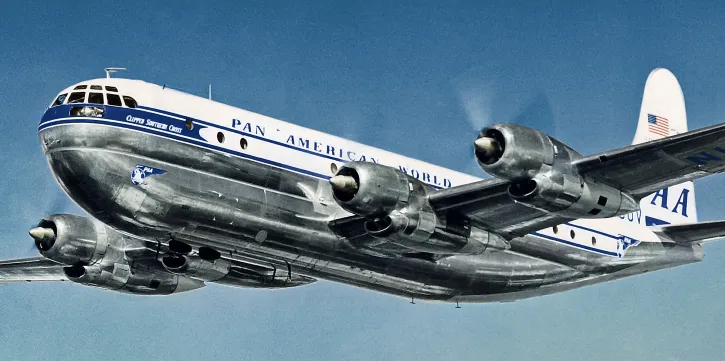
Boeing Stratocruiser, The Jumbo Of The 50s, Brought To Life With Colour
Feb 07, 2024

The Boeing Stratocruiser, a marvel of aviation from the 1950s, epitomized luxury air travel with its spacious design and innovative features. This grand aircraft, a derivative of the iconic B-29 Superfortress, offered passengers a unique experience, complete with expansive lounges and sleeping quarters. Its vibrant color schemes and elegant interiors made it a flying hotel, attracting elite travelers seeking comfort and style. With its distinctive humpbacked silhouette and powerful engines, the Stratocruiser not only transformed air travel but also symbolized the optimism and glamour of the post-war era, forever leaving its mark on the history of aviation.
The Boeing Stratocruiser: An Icon of Aviation History
The Boeing Stratocruiser, often dubbed "The Jumbo of the 50s," represents a significant leap in aviation technology and luxury. This aircraft was designed to cater to the growing demand for transcontinental air travel, combining the spaciousness of a luxury liner with the speed of modern aircraft. With its iconic shape and innovative features, the Stratocruiser set the standard for air travel in its time.
Design and Features of the Boeing Stratocruiser
The Stratocruiser was a marvel of engineering, showcasing several features that distinguished it from its contemporaries. Here are some key specifications:
| Feature | Details |
|---|---|
| Length | 99 feet 6 inches (30.4 meters) |
| Wingspan | 117 feet 6 inches (35.8 meters) |
| Height | 28 feet 10 inches (8.8 meters) |
| Maximum Speed | 350 mph (563 km/h) |
| Range | 4,500 miles (7,200 kilometers) |
With a capacity of up to 100 passengers, the Stratocruiser featured a double-deck layout that included a lounge area and a dining space where passengers could enjoy meals in comfort. The interior was adorned with vibrant colors and luxurious materials, reflecting the opulence of the 1950s.
Innovative Technology in the Stratocruiser
The Boeing Stratocruiser was equipped with several technological advancements that enhanced its performance and passenger experience. One notable feature was its pressurized cabin, allowing it to fly at higher altitudes while providing a comfortable environment for travelers. This innovation was a game-changer in the aviation industry, as it significantly reduced travel time across long distances.
Additionally, the Stratocruiser was powered by four Pratt & Whitney R-4360 Wasp Major engines, each capable of producing over 3,500 horsepower. This power allowed the aircraft to cruise at high speeds while maintaining stability and control.
The Cultural Impact of the Stratocruiser
The Boeing Stratocruiser not only revolutionized air travel but also became a symbol of the post-war era. Its introduction coincided with a period of economic growth, and air travel became synonymous with luxury and adventure. Many people viewed flying as an exciting and glamorous experience, and the Stratocruiser embodied that sentiment.
To understand the cultural significance of the Stratocruiser, it's essential to consider how it influenced travel trends during the 1950s. Airlines began to market their services as a lifestyle choice rather than just a mode of transportation. The Stratocruiser, with its spacious seating and stylish interior, was a central part of this marketing strategy.
The Legacy of the Boeing Stratocruiser
Despite its relatively short production run, the Boeing Stratocruiser left a lasting legacy in the aviation world. It paved the way for future developments in commercial aviation, influencing the design of later aircraft. The emphasis on passenger comfort and innovative technology seen in the Stratocruiser can be seen in modern airliners today.
Moreover, the Stratocruiser has become a beloved aircraft among aviation enthusiasts and collectors. Many examples of this iconic airplane have been meticulously restored and are now featured in museums and airshows worldwide. Its vibrant colors and distinctive design continue to capture the imagination of aviation fans, making it a celebrated piece of history.
Conclusion: The Stratocruiser's Enduring Appeal
The Boeing Stratocruiser, known as "The Jumbo of the 50s," is more than just an aircraft; it represents a transformative period in aviation history. With its innovative design, luxurious amenities, and cultural impact, the Stratocruiser remains an enduring symbol of the golden age of air travel.
As we look back on this remarkable aircraft, it is a reminder of how far aviation has come and the importance of comfort in the skies. The Stratocruiser's colorful legacy continues to inspire a new generation of aviators and travelers, cementing its place as an icon of the skies.
For anyone interested in aviation history, the Boeing Stratocruiser is a must-know piece of the puzzle, illustrating the blend of innovation, luxury, and cultural significance that defined air travel in the 1950s.
Related Articles

Explore Thailand: The Best Islands to Visit for Paradise, Adventure, and Relaxation

The Ultimate Guide to the Best Islands in Thailand for Your Next Getaway

Do babies need passports? How to get a passport for a newborn

How to get a U.S. passport fast: here’s how to expedite the process

What is Mobile Passport Control: 5 reasons why you should use it

SENTRI vs. Global Entry: A detailed guide

Do you need a passport to go to the Bahamas? Let’s find out

Do you need a passport to go to Mexico? A detailed guide

Do you need a passport to go to Canada? We got the answer

Do You Need a Passport for a Cruise: An Essential Travel Guide

Booster Seat Requirements: All the Rules to Follow in Your Rental Car

What Are the World’s Most Powerful Passports, and How Does Yours Rank?

How to Take a Passport Photo at Home: A Helpful Guide

You've got to have heart! Southwest's new livery

Your opinion: Should water be free on low cost carriers?

Young women bolder than guys as solo travellers
